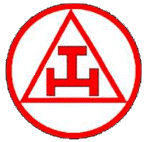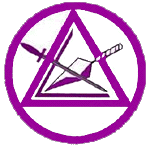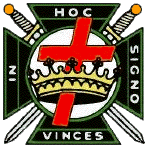
The term York Rite is a term most often used in the United States of America to refer to a collection of Masonic degrees that, in most other countries, are conferred separately. As such, it constitutes one of the two main branches of Masonic Appendant Bodies in United States Freemasonry, which a Master Mason may join to further his knowledge of Freemasonry. Its name is derived from the city of York, where, according to a Masonic legend, the first meetings of Masons in England took place, although only the lectures of the York Rite College make reference to that legend.
The divisions within the York Rite and the requirements for membership differ from jurisdiction to jurisdiction, but the essentials are the same. In all the workings, the one requirement is that all applicants be in possession of the degree of Master Mason (the third degree of Freemasonry).
The York Rite is not found as a single system in the majority of countries outside the United States, nor are any of the separate degrees subject to the local Grand Lodge jurisdiction. Each sovereign and distinct rite or “Order” elsewhere has some differences in ritual details to the York Rite system. However, provided that the Grand Lodge in question regards the parent “Craft” jurisdiction as regular, each distinct Order has recognised fraternal inter-relations with the respective Rite within the York system.
The York Rite in the United States is actually a grouping of separate Rites joined in order, namely the Capitular Rite, or Royal Arch Masons (General Grand Chapter – Royal Arch Masons International), the Cryptic Rite, or Cryptic Masons (General Grand Council – Cryptic Masons International) and the Chivalric Orders, or Knights Templar (Grand Encampment of Knights Templar of the United States of America).
The bodies of the York Rite are:
 Royal Arch Masonry
Royal Arch Masonry
Royal Arch Masonry is the first order a Master Mason joins in the York Rite. The Chapter works the following degrees:
—The Mark Master Mason degree is in some respects an extension of the Fellow Crafts’ second degree. In some jurisdictions the degree is conferred in a Fellow Craft Lodge, that is, the second degree of the Blue Lodge.
— The Past Master (Virtual) degree is conferred because of the traditional requirement that only Past Masters of a Blue Lodge may be admitted to Holy Royal Arch. Because there are so many applicants for this degree, Virtual Past Master is required to qualify them for it. Much of the work is the same given to install the Worshipful Master of a Blue Lodge. There is no such requirement or procedure outside the USA.
— In the Most Excellent Master degree the building of King Solomon’s Temple, which figures so prominently in Blue Lodge, has been completed. In England the degree is conferred by Cryptic Councils, along with three other degrees below.
— The Royal Arch Mason degree is said by many to be the most beautiful degree in all of Freemasonry. Following the convocation of Supreme Grand Chapter in England on November 10, 2004, there are significant ritual differences from that worked in the USA, fraternal inter-relations remain as before. Freemasons who reach this degree may continue to Cryptic Masonry or go straight to Knights Templar (where permitted—requirements vary in different jurisdictions).
 Cryptic Masonry
Cryptic Masonry
Membership in the Council of Cryptic Masons (or the Council of Royal and Select Masters in Great Britain and several states in the USA) is not required for membership in the Knights Templar in some jurisdictions, so it is frequently skipped. It is called Cryptic Masonry or the Cryptic Rite because a crypt or underground room figures prominently in the degrees.
— Royal Master
— Select Master
— Super Excellent Master
— In Great Britain, a Most Excellent Master degree is offered between Select Master and Super Excellent Master.
 Knights Templar
Knights Templar
The Knights Templar is the final order joined in the York Rite. Unlike other Masonic bodies which only require a belief in a Supreme Being regardless of religion, membership in Knights Templar is open only to Royal Arch Masons who promise to defend the Christian faith. Its affiliation with Masonry is based on texts that indicate persecuted Templars found refuge within the safety of Freemasonry.
A local Knights Templar organization is called a Commandery in the United States and a Preceptory elsewhere. In the United States, Knights Templar consists of three degrees.
— Illustrious Order of the Red Cross
— Order of the Knights of Malta (or simply Order of Malta)
— Order of the Temple
Equivalent bodies outside the USA
Mark Man and Mark Master
England, Europe and Australasia – The Mark degree is conferred in a separately warranted Lodge of Mark Master Masons. The candidate for Advancement is required to be a Master Mason. A further degree is conferred by a Mark Lodge which is not present in the York Rite, that of Royal Ark Mariner. In Canada, the Royal Ark Mariner degree is conferred by a Council of Royal and Select Masters.
Scotland – The Mark degree is conferred in a Craft lodge and is seen as the completion of the Fellow Craft Degree, but the candidate for Advancement is required to be a Master Mason. The Mark may alternatively, and exceptionally, be conferred in a Holy Royal Arch Chapter as a prerequisite for Exaltation to the HRA. If a Candidate has already received his Mark Degree in his Craft Lodge, then his initiation into the Chapter is preceded by a short ceremony of Affiliation to the Mark Lodge associated (“moored”) to that Chapter.
Holy Royal Arch
A Holy Royal Arch ChapterThe Degree of the Holy Royal Arch is very similar to that of the Royal Arch Mason in the York Rite and contains many layers of complexity within its ritual. A candidate for Exaltation is required to have been a Master Mason for four weeks or more. In Scotland the candidate must also be a Mark Master Mason, a degree which can be conferred within Chapter if required.
— England, Europe and Australasia: A Holy Royal Arch Chapter is required to be sponsored by a Craft Lodge and bears the same name and number; however, the HRA is seen as a separate order. Supreme Grand Royal Arch Chapter is governed from the headquarters of United Grand Lodge of England, but the administration remains distinct. The degree is termed the ‘completion of the Master Mason degree’ by virtue of the relationship between the ritual content.
— Scotland: The degree is conferred in a Royal Arch Chapter which is within a wholly different administrative structure (the Supreme Grand Royal Arch Chapter of Scotland). Due to a difference in ritual, Royal Arch Masons exalted in England may not attend Scottish Royal Arch Chapters without completing the Scottish exaltation ceremony. Before receiving the Holy Royal Arch Degree the Candidate must first have the Mark Degree and the Excellent Masters Degree. However, those Exalted in Scotland may attend Chapter in England, or indeed any Chapter, provided it be in Amity.
— Council of Royal and Select Masters
Outside the United States the Cryptic Council confers the four degrees identified above. Candidates are required to be members of a Royal Arch Chapter and a Mark Master Mason.
The Knights Templar
Officially known as The United Religious, Military and Masonic Orders of the Temple and of St John of Jerusalem, Palestine, Rhodes and Malta, this order is colloquially known as the Knights Templar. Bodies of the order are known as Preceptories. In Great Britain and other countries these Preceptories confer three degrees:
— Knight Templar
— The passing Order of St. Paul
— Order of Malta
Membership is by invitation and candidates are required to be Master Masons, holders of the degree of the Holy Royal Arch and to sign a declaration that they profess the Doctrine of the Holy and Undivided Trinity. In the United States, this body is officially known as the Knights Templar. It is not invitational, though the same membership requirements still apply, and the body itself is called a Commandery. In some jurisdictions, membership in a Council is required prior to being eligible for the Knights Templar, and there are non-Christians who are members in some Commanderies.


